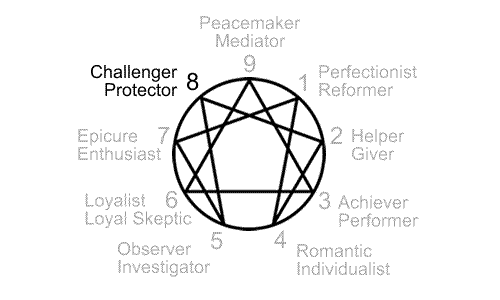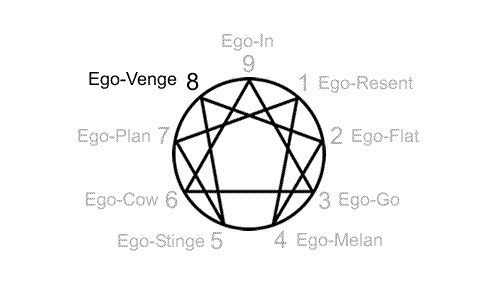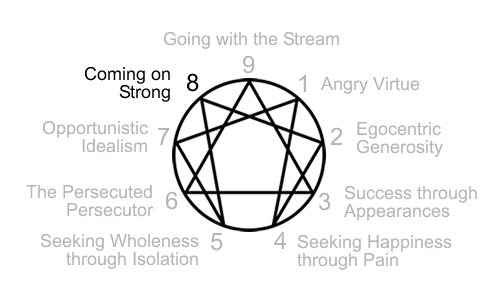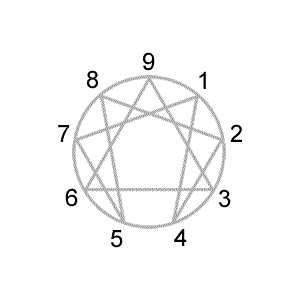Enneagram Type 8: Empowerment through Behavioral Assertiveness
The core focus of Enneagram type 8

Freedom is never voluntarily given by the oppressor; it must be demanded by the oppressed.
- Martin Luther King, Jr.
Early in life we develop an initial belief about ourselves and a compensation for that self-belief.
-
Type 8 Initial Self-Belief: “I am disempowered as I am.”
Type 8 Compensation: "I must be direct in going after what I want and stand strong against being controlled or taken advantage of."
Over time this gets generalized beyond the self into a core focus that also shapes how we perceive and interact with the world at large.
-
Type 8 Core Focus: Empowerment comes from being in control and not being controlled by people or rules. This requires that I confront obstacles and people that are in my way and move directly toward what I want. Don't show weakness in a world that takes advantage of innocence and vulnerability.
Personality characteristics that might arise from the type 8 core focus include:
- Takes action decisively and sometimes impulsively
- Fills up the space around them with their presence and big energy
- Speaks directly and bluntly when making a point
- Often guards against vulnerability by denying softer emotions
- Naturally assumes role of leadership when there's a power vacuum
- Directly confronts others to reveal the truth of a situation
- Protects or seeks justice for those unfairly taken advantage of
- Anger arises in service of making things happen/getting things moving
- Prefers to make their own rules rather than follow others' rules
Enneagram author descriptions of type 8

Below are Enneagram type 8 description samplings from some popular or well-known Enneagram authors. Click on the sources after the descriptions to further explore these interpretations.
-
The Challenger, The Powerful, Dominating Type: Self-Confident, Decisive, Willful, and Confrontational1
Basic Fear: Of being harmed or controlled by others, of violation1
Basic Desire: To protect themselves, to determine their own course in life1
-
How Eights Pay Attention: Eights have several ways to not perceive threatening information. Their psychological defenses revolve around an idea of themselves as more powerful than any potential opposition, so consequently their perceptions tend to maximize their own strengths and minimize an opponent’s real advantages.2
Basic Proposition: You gain protection and respect by becoming strong and powerful, imposing your personal truth and hiding your vulnerability.2
Strengths: Courageous, strong, fair, truthful, determined, generous, protective of others2
Challenges: Excessive, angry, dominating, lustful, afraid of vulnerability2
-
Energy goes into: Control and dominance of my space and inadvertently of the people and things in my space. Taking direct action and facing conflict. Protecting the weak and innocent. Gaining respect by being strong and just.3
-
The Challenger: Commanding, intense and confrontational, they are motivated by a need to be strong and avoid feeling weak or vulnerable.4
-
Asserters are direct, self-reliant, self-confident, and protective.5
-
Focus of Attention: Eights naturally focus their attention on power and control—who has it and who doesn’t, and how it’s wielded. They think in terms of the big picture and (mostly) dislike dealing with details. They see the world as being divided into “the strong” and “the weak,” and they identify with “the strong” to avoid feeling weak.6
Sources
1Book: The Wisdom of the Enneagram; Website: The Enneagram Institute
2Book: The Enneagram; Website: The Narrative Enneagram
3Book: The Essential Enneagram; Website: Dr. David Daniels
4Book: The Road Back to You
5Book: The Enneagram Made Easy
6Book: The Complete Enneagram; Website: Chestnut Paes Enneagram Academy
Type 8 Ego: Ego-Venge

The roots of the Enneagram types come from Oscar Ichazo's ego types. The ego types identified how a person was fixated in ego and the remedy for finding freedom from that.
Below are descriptions of Oscar Ichazo's ego type 8 fixation, trap, holy idea, passion, and virtue reinterpreted for today's Enneagram personality types.
Type 8 Fixation and Trap
Fixation: Vengeance comes from balancing the scales of justice when others attempt to take unfair advantage.
Trap: Justice pushes to reveal hidden truths that you imagine others to be hiding beneath the surface.
The fixation of vengeance points to the mental preoccupation of the type 8 ego. The trap of justice keeps an individual stuck in the fixation.
Type 8 Holy Idea
Holy Idea: Holy Truth is knowing that each person has their own truth to live by and often it won't be the same truth that seems so obvious to you.
The fixation of vengeance and trap of justice keep an individual stuck in the type 8 fixation. The way out of that fixation is through holy truth.
Type 8 Passion
Passion: Excess of expansive energy that needs to be released through activity and expression. "This energy feels natural for me but I may have to sit on it when others find it too much."
The passion of excess is the emotional energy that serves the fixation of vengeance and trap of justice.
Type 8 Virtue
Virtue: Innocence appears when you allow yourself to experience tenderness and vulnerability instead of habitually pushing out against the world.
The virtue of innocence is what appears when the passion of excess subsides.
Personality traits of Enneagram type 8

A psychiatrist named Claudio Naranjo evolved Oscar Ichazo's ego-types into the Enneagram personality types as we use them today. Naranjo largely based the types on Ichazo's passions.
Naranjo outlined the following trait structure for type 8 (Ennea-type VIII) in his books Ennea-type Structures and Character and Neurosis.
- Coming on Strong - Lust and Vindictive Arrogance
- Lust
- Punitiveness
- Rebelliousness
- Dominance
- Insensitivity
- Conning and Cynicism
- Exhibitionism (Narcissism)
- Autonomy
- Sensorimotor Dominance
Enneagram type 8 examples
While reading about the Enneagram types can be useful in understanding them, you eventually have to bring the types to life by seeing the many different ways they get expressed in life.
While the ideal is to be able to interact directly with people of each type, an alternative is to observe them from a distance. There are a number of ways to do this using videos. Many of these videos can be found on the Internet if you know what to look for (YouTube in particular).
- Type 8 Interviews and Self-Revelations
One method used to bring the types to life when teaching the Enneagram types involves interviewing people of a given type about how that type plays out in their life. This may be done through panels and one-on-one interviews.
Self-revelatory videos can also be useful where a person simply describes their type to a camera without the prompting of an interviewer.
Note that sometimes a person in a video may have been mistyped and may not offer an accurate representation of type when that happens.
- Type 8 Celebrities or Famous People
Once their Enneagram type is known, celebrities or famous people can also offer interesting examples of and insights into Enneagram type as revealed through interviews, lectures, writings, and the person's work.
However, it's not like the Enneagram panels, interviews, and self-revelations where people are specifically describing how they experience Enneagram type in their lives. It's more a matter of looking for glimpses into how Enneagram type is operating in the person.
It can be difficult to type someone at a distance. Look for a consensus of opinion on a person's type from multiple sources and hold it loosely. Celebrities and famous people are often typed differently by different Enneagram authors, teachers, and enthusiasts.
- Type 8 Fictional Characters
It needs to be made clear that fictional characters are not real people, even when they are based on real people. There can be a temptation to assign Enneagram type to every character in a story, but many characters don't have that kind of consistency or depth.
Not only might there be a number of different people, usually of different types, influencing the creation or portrayal of a character but often the character is nothing more than a vehicle for telling the story and moving it along.
While once in a while a character appears that you can attribute an Enneagram type to, generally it's more accurate to look at specific scenes as examples of a type rather than the character as a whole.
Tom Condon wrote a book called The Enneagram Movie & Video Guide that you may find useful for seeing type in fictional characters.
- Type 8 Songs and Lyrics
Although they do exist, there are few song lyrics that can be attributed to one particular Enneagram type. Most songs have both lyrical and musical elements that can be attributed to a number of different Enneagram types.
Songs are extremely subjective. There are many songs that listeners, and even performers, interpret in a very different way than the song writer intended. A number of songs also emphasize the sounds of words rather than their meaning.
As such, different people hearing the same song often will experience it as representing different Enneagram types.
Enneagram type 8 variations
There are a number of variations or flavors of type 8 that help explain why two people of the same type seem different. Click below for more info about variations of type 8.
Type 8 mistypes
Some people correctly identify their Enneagram type on their first try. For most other people determining type can take some time.
If you feel that you may have wrongly typed yourself as type 8 and have one or more alternative candidate types in mind then click on a link below to take a quick Enneagram test comparing type 8 to another type that may instead be your type.
Enneagram Tests to Help Determine Type

The Enneagram personality types consist of nine basic types. One of the types will be more dominant than the others. This dominant type is said to be "your Enneagram type".
Although there are nine basic Enneagram types, there are also many variations within each type as defined by such concepts as wings, centers, and instincts.
You can explore these variations using the type preference test below or one of the many other tests available on this website.
-
Enneagram Type Preference Test
This test produces a scored list of all nine types.
Questions are forced-choice, similar to the method used by the Riso-Hudson Enneagram Type Indictor (RHETI).
Use to determine type, wings, gut/heart/head types, and tri-center. -
Enneagram Type Comparison Test
This test compares any two types. The preferred type will have the higher score.
Use when you've narrowed your type down to two or three possibilities you'd like to compare.
Click here for the Complete Guide to the Enneagram.
This free guide explains- the nine Enneagram personality types
- the many type variations within type
- where the types came from (origins and history)
- how the types use the Enneagram symbol
Click here for Enneagram tests.
These free tests help you find your- primary type
- candidate types
- preferred wing
- intinctual subtype
- instinctual variant stacking
- center types (gut, heart, and head)
- tri-center with wings